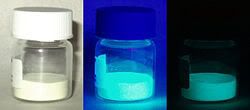Chemiluminescence
 Chemiluminescence is chemical reaction the emit energy as a light but without temperature chane. It is much less common for a chemical reaction to produce light without heat.While the light can, in principle, be emitted in the ultraviolet, visible or infrared region, those emitting visible light are the most common. They are also the most interesting and useful.
Chemiluminescence is chemical reaction the emit energy as a light but without temperature chane. It is much less common for a chemical reaction to produce light without heat.While the light can, in principle, be emitted in the ultraviolet, visible or infrared region, those emitting visible light are the most common. They are also the most interesting and useful. The light from such reactions is called cool light, because it is created without heat. Reactions that produce light without heat are called chemiluminescent reactions. Perhaps the most familiar chemiluminescent reactions are those that occur in living organisms. Fireflies produce light without heat by a chemiluminescent reaction. Chemiluminescent reactions that occur in living organisms are called bioluminescent reactions.
Chemiluminescent reactions can be grouped into three types:
- Chemical reactions using synthetic compounds and usually involving a highly oxidized species such as a peroxide are commonly termed chemiluminescent reactions.
- Light-emitting reactions arising from a living organism, such as the firefly or jellyfish, are commonly termed bioluminescent reactions.
- Light-emitting reactions which take place by the use of electrical current are designated electrochemiluminescent reactions.
Chemiluminescent and bioluminescent reactions usually involve the cleavage or fragmentation of the O-O bond an organic peroxide compound. Peroxides, especially cyclic peroxides, are prevalent in light emitting reactions because the relatively weak peroxide bond is easily cleaved and the resulting molecular reorganization liberates a large amount of energy.



